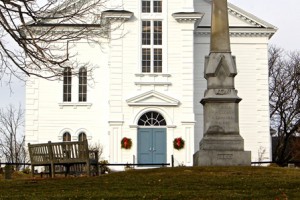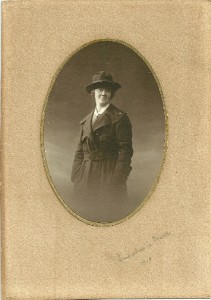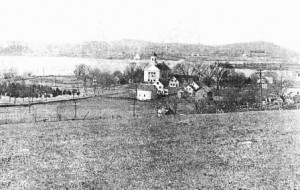By Donna McDaniel, Special Contributor

(Photo/Sue Wambolt)
Southborough – The stories of those who have shaped Southborough may best be told by remembering families important in the community for several generations. Some were by necessity farmers for as many as two centuries; others – “gentlemen farmers” – have given the town some distinctive features through contributions of their time and their wealth. Whatever their circumstances, they are the people who have made Southborough what it is today.
The individuals and families who shaped Southborough from before its 1727 separation from Marlborough to the present have built churches, laid out streets, operated saw mills and small factories, and managed dairy farms and orchards – all the while living their commitment to their community, serving in town offices, creating schools and churches, and supporting the Farmers’ Club, Masons, Rotary and Lions clubs, the Southborough Women’s Club and Catholic Women’s Club, the Historical Society, American Legion and VFW posts, and organizing youth programs like the Scouts, plus a host of others.
As “Fences of Stone,” the town history, reported, by the middle 1800s whether they lived in mansions or farm homesteads, Southborough’s well-to-do and the not-so-rich were good

(Photo/courtesy Southborough Historical Society)
neighbors, worshipping together, supporting local causes and charities, and attending local events.
Farmers/founders
1. The Johnsons: Arriving even before the town had separated from Marlborough, the Johnsons developed the first farm in the west end – and three centuries later were the last to sell their herd. The first town moderator was a Johnson and over the years, Johnsons could be found driving kids to school and serving on numerous town boards.
2. The Onthanks also were here before the Revolution and more than one selectman has answered to that name. Along with the Ellsworths and Brewers, their farms were on the Framingham border. Their “market gardens” provided good summer jobs for town boys who in the fall were apple picking at Davco Farm, now town conservation land just south of Route 9 above the reservoirs.
3. The Killams, Watkins and Norcross families farmed fields stretching south toward Hopkinton. Going north, farmland on the sides of East Main Street was occupied in the 19th century by Bolands, Mauros and Mattiolis, many of whom who found work on the larger farms and in town departments – including police and fire where to this day fathers and sons and brothers have served in the ranks and as chiefs.
4. Not far west of the town center were the properties of the wealthy, including J. Montgomery Sears, owner of Wolfpen Farm which delivered milk (in glass bottles) in Southborough and surrounding towns well into the 20th century.
5. Francis B. Fay, one of many Fays, had a special role as the community moved into the 19th century. As chair of the “Southborough Franklin Institute” whose role was “the diffusion of moral intelligence and
scientific research,” he revealed his commitment to create programs that nurtured the intellect. Even women were invited to debates (Example: “Is slander or theft a greater evil in society?”) Speaking at the town’s 1827 centennial, Fay told the people how proud they could be “about how far the town had come.”
But Fay was to make the town prouder. When 1852 Town Meeting voters hesitated about approving money for a town library, Fay shook a bag of clinking silver coins as his donation and challenged the people to contribute another 500 – which they did. The result was a book collection first housed in the back of the Town House and later moved to the new building in the town center – not only physically but in the life of the community.
6. Librarians: The years have given Southborough a small collection of librarians who appreciated the library’s role as a central and welcoming place and so they have been among the most beloved in the community – from Sadie Hutt to Fanny Buck and Mary Lee Cox and Judy Williams and the children’s favorite for 34 years: Jeanette (Jay) Curtin.

Photo/Southborough Historical Society
7. Burnetts: The fact is that, even with so many farms and families, one stands out in the town history – Deerfoot Farm and the man who developed it – Joseph Burnett, a Bostonian made wealthy by manufacturing extracts such as vanilla. He built a large dairy farm between Deerfoot and Parkerville roads, made famous for many reasons. It was home to the first herd of Jersey cows in America (1854), a producer of butter sold to English royalty, and maker of “Deerfoot Sausage” made for decades on Newton Street.
Joseph Burnett’s desire for a church soon gave the community St. Mark’s Church adjacent to the Town House and the Pilgrim Church. Burnett’s desire for a school nearby for his sons brought another of the family’s notable contributions to Southborough: the founding of St. Mark’s School (1865) and then next year the Fay School, founded by Burnett’s cousins – Elizabeth Burnett Fay and Harriet Marcella Burnett with family support, especially from Joel Burnett and Sylvester Fay. The school on Main Street across from the church was open to male boarders.
The farms, the factory and private schools meant jobs for many Southborough residents, jobs especially important to those who came as laborers on the dam and wanted to make the town their home. Many ended up staying in a town with several large farms and two private schools which depended on groundskeepers and kitchen workers and so on. Southborough also had a share of wealthy homeowners looking for household help. Instead of moving along to another town, likely to work in a mill, dozens of workers stayed in town. So it is that a century later, the children of those workers found work as police or firefighters or in public works like the highway, cemetery and water departments. Maintaining school properties also meant jobs using the skills of people who had come for the dam project.
8. By 1898, the Boston Water Commission was looking to the Upper Sudbury River to fill the need for another source of water for the city. A 100-feet high granite dam was built where the river crosses from Southborough into Framingham. The huge project involved moving an enormous amount of soil (some to create the reservoirs) and some the dam. Dozens of workers were brought to town, some of them stonecutters brought from Italy.
Essentially the dam changed the future of Southborough in two ways. First, the small mills and factories along Stony Brook in Fayville lost their source of power, meaning the stream would not be lined by mills as in other towns. Second, many of the workers who came stayed in town after the project was completed.
9. Another benefactor – Charles F. Choate, a resident and lawyer with the family’s Boston firm – left a much appreciated gift to the newly formed Village Society in the 1920s – the Community House (at Main Street and Cordaville Road). His only condition was that the American Legion Post have a room there. They do and the house continues to be a hospitable location for small social activities and meetings. In memory of his son, Choate also donated a field and a fund to be used for athletic and recreational purposes.
10. Not to be forgotten are a long list of clergy, the first being the Rev. Nathan Stone, both minister and a town leader from 1730 on. In 1886 Rev. John Redican became the first permanent full-time Catholic priest in what had been a “mission” parish under the care of Westborough. Redican’s first goal was to raise money to build St. Matthew’s in the southern part of town known as Cordaville. St. Ann’s Church on Boston Road in the center of town was built in 1887.
11. Cordaville has its own history, mostly growing out of the mills on the lower Sudbury River separating Southborough and Hopkinton. Like other mills, the stone structure built by Milton Sanford relied on the water power to produce textiles, the best known were blankets for the Civil War. Products were shipped on the railroad running right by the property.
In 1847, Sanford, who came from a family of mill owners, had plans drawn up for a complete mill village. It was named after his wife, Cordelia – thus Cordaville and the road by that name. Even after an 1855 fire, Sanford managed to adapt to changes. By 1905 his was one of just three major mills in town. But in 1928 the entire mill, equipment and some dwellings (still in use) were auctioned off.
12. Teachers: Southborough has shown its appreciation of much beloved teachers by naming schools for them: Margaret Neary, Mary Finn (the teacher remember for expecting her students to memorize the Gettysburg Address), school principals Albert Woodward and Brent Trottier. The town’s high school was named after Henry H. Peters, a well-off farmer on Chestnut Hill Road; he donated the money for the school and was a benefactor for several other town projects.
13. Two remarkable women: Eleonora Fantony Burke and Angeline Bagley Mattioli. Not that women haven’t always done valuable work, but two Southborough women did things extraordinary for their time. Angeline Bagley went to Europe as an Army nurse in World War I. When she came home, she married Francis J. Mattioli, the town’s first full-time police chief. Her son and nephew eventually served on the force, too.
After high school, Eleanora planned to become a teacher but her father (an Italian immigrant) insisted she go to law school. She commuted to Boston and in 1935 opened her own practice in Framingham. She married a fellow Peters High graduate Philip Burke. In 1937 she became Southborough’s town counsel, the first woman in the state to hold that position. In 1957 she was elected town clerk, serving for 10 years. Into her 80s Eleanora was a faithful attender at various town and committee meetings and lived up to her reputation for freely sharing her not-always-welcomed opinions.
One reminder of the names of many who contributed greatly to the town is to notice street names. A few examples: Ward Road, Brigham Street, Nathan Stone Road, Hubley Lane, William Onthank Lane, Sadie Hutt Lane, Sears Road, and Newton Street. Time to start your own list.
















